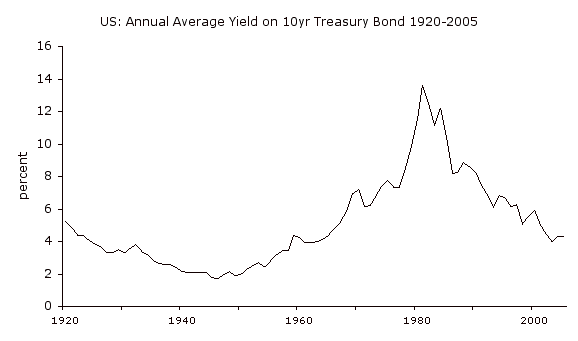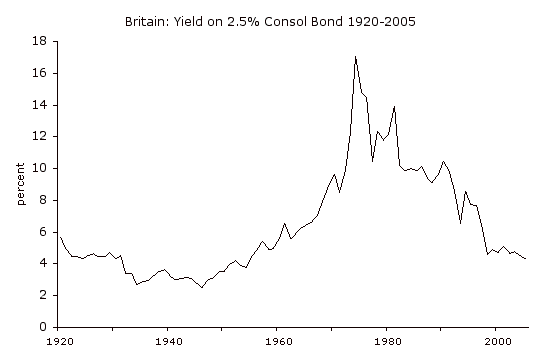The “Lowering Interest Rates” Boondoggle
September 21, 2008
In practice, the most effective way to produce low interest rates is to ensure the reliability of the currency. This means a gold standard. When a currency is considered to be reliably pegged to gold, interest rates typically fall to the mid-3% for the government and the 4%-5% range (die 50 bps to 150 bps over the government rate) for high-quality commercial loans. This was true in Rome under Augustus, around 10 AD, it was true in Amsterdam in the 17th century, Britain in the 18th and 19th centuries, and the U.S. in the 1950s. Indeed, as I explain in my book, a major reason that Britain adopted a formalized gold-based currency in 1698 was to promote lower interest rates.
This being the case, it should be most odd that the great advantage claimed by the currency manipulators is the ability to “lower interest rates.” I mention in my book that nobody seems to notice that when Keynes published his General Theory in 1936, the bible for two generations of currency manipulators and the great paean to the government “lowering interest rates” in a recession, that the yield on the 10-year U.S. Treasury bond was about 2.76%! Wasn’t that low enough? In Britain, it was 2.96%.


How did the yields get so low? It wasn’t central bank manipulation in those days. Keynes was just starting to make those arguments. It wasn’t until the 1940s that Keynes’ arguments were being put into practice, and even then it was within the confines of the existing gold standard system. The central banks were not free to “lower interest rates” as they pleased until floating currencies appeared after 1971.
So — although there were some complications and minor details — it is reasonable to say that the low interest rates of the 1930s came about via the unmolested free market, within the context of a gold standard.
What this means is: you don’t need a government to “lower interest rates.” They go down all by their damn selves. Anyone involved in the markets will tell you that when the prospects of getting paid via equities or risk bonds look shaky, in a recession for example, people rush into Treasuries, driving their price up and their yields down. This assumes, of course, that the currency of denomination for the government bonds is reliable, which in practice means pegged to gold.
An economist might say that the bond yield reflects the return on capital available in an economy. When it seems like you can get a high return on capital by investing in a commercial enterprise, you sell your low-risk bond and invest the money elsewhere. This tends to drive interest rates up until they reach a point at which they are attractive compared to risky ventures, on a risk-adjusted basis. The opposite applies in an environment where returns on new investment appear to be low. Thus, on a theoretical level too, it makes sense that interest rates decline in a recession, assuming stability of currency value.
We can see from these charts, too, that if a gold standard system tends to lead to the lowest possible sustainable interest rates, quite sensibly any system which is not a gold standard leads to higher rates. The floating currency system in place since 1971 led to an explosion of currency devaluation, inflation, and higher rates. Indeed, rates began to rise from around 1950, as central banks were already starting to play the manipulation games that got a lot more serious in the 1970s.
Here is a little more detailed look at the early 1930s. It’s from Milton Friedman’s Monetary History of the United States:
The Fed’s discount rate in those days basically reflected interbank rates generated in an unmanipulated market. The series where the label got smudged is the yield on BAA corporate bonds. We see that the mostly-unmanipulated free market was perfectly capable of taking short-term rates to about 1.5% in mid-1931. That is low enough for the most ardent “lower interest rates” fan. Notice a major selloff across the yield curve beginning in September 1931, which is when Britain devalued the pound. This led to selling pressure on the dollar as well, and the process by which base money was removed to support the dollar and maintain its gold peg also resulted in briefly higher interest rates. Economists today make a big deal of the rise of the discount rate to a whopping 3.5% during this period. It wasn’t that important. The Great Depression didn’t happen because someone had to pay 3.5% annualized interest. You would think this was obvious.
So, let’s summarize:
1) Over the long term, a gold-linked currency allows the lowest possible interest rates.
2) With a gold-linked currency, and without government manipulation, market interest rates would go down all by themselves in a recession situation.
3) This had been well established by the mid-1930s, as interest rates had already fallen to multi-decade lows.
4) Nevertheless, a whole generation of economists decided that they wanted a currency manipulation body to “lower interest rates” in the case of a recession.
This makes no sense. Or does it?
Of course we are now very familiar with this interest rate-manipulation system. We’ve been living with it for several decades now. It was only theoretical in Keynes’ time. We’ve seen that there are many problems with such a system, such as the 1970s inflation or the many currency disasters worldwide that have been taking place at a regular clip. We have also demonstrated that this system, over 40 years of trying by many central banks around the world, has never produced sustainable interest rates as low as that produced by a gold-standard system.
It would seem that this interest-rate manipulation system doesn’t really produce anything worthwhile.
If you ask the mainstream economists what great advantage this floating currency system provides, they will typically counter with two responses:
1) We can’t go back to a gold standard system because of blah blah blah. The problem here is that today’s economists don’t know how to establish and manage a gold standard system. Thus, although it is indeed possible and in fact very easy to implement, as far as they are concerned it’s impossible because they don’t know how to do it. We saw this a few weeks ago: Why Not the Gold Standard?
2) We want to be able to “lower interest rates” in the case of a recession/depression. Or, the gold standard prevented governments from “lowering interest rates,” which made the Great Depression worse, etc. etc.
OK, fine. This “lowering interest rates” must be so wonderful that we will put up with all the other disasters caused by floating, manipulated currencies — and even though the market would “lower interest rates” automatically anyway. So, what happens when we “lower interest rates” in response to recession? Hmmmm?
“Pushing on a string” is what happens.
Inevitably, when central banks “lower interest rates”, the results are disappointing. I don’t think there’s been a single example where “lowering interest rates” produced anything particularly positive — with the possible exception of the 2002-2003 period, when there was indeed a ridiculous credit boom which soon after laid waste to just about the entire financial system.
In short, this “lowering interest rates” doesn’t accomplish much, or at least you better hope it doesn’t. It’s pretty safe to say that it doesn’t accomplish much more than what would have happened under a gold standard, when rates would have fallen anyway. And, everybody knows this.
My conclusion is that all of this “lowering interest rates” talk is really just a cover for something a lot simpler: currency devaluation, that oldest of economic band-aids. Because, while “pushing on a string” doesn’t have much effect, currency devaluation does have very large effects. Just about all the currencies in the world were devalued beginning in 1931. This was not done via a central bank and “lowering interest rates.” Mostly it was an overt policy of the central government, and the central bank was just along for the ride.
My suggestion: if you want to devalue the currency, just devalue it. Let’s not get involved in this stupid system of “lowering interest rates.” Or, to put it in more practical terms, have a gold standard, and if, for whatever reason, people want to devalue the currency, then devalue it, but stay on a gold standard. The U.S. devalued from $20/oz. to $35/oz. in 1933 — but it didn’t leave the gold standard. The dollar remained pegged at $35/oz. until 1971. This was basically OK. If you have one or two devaluations a century, of similar size, that would be tolerable. An even better solution: don’t devalue the currency. Whatever the economic problem is, it wasn’t caused by a currency that is too stable. Just fix whatever is causing the problem, without playing games with the currency, causing new problems.
That’s pretty much the response to the last 70 years of blah blah from the academic economists. You see, this stuff really isn’t that hard.

